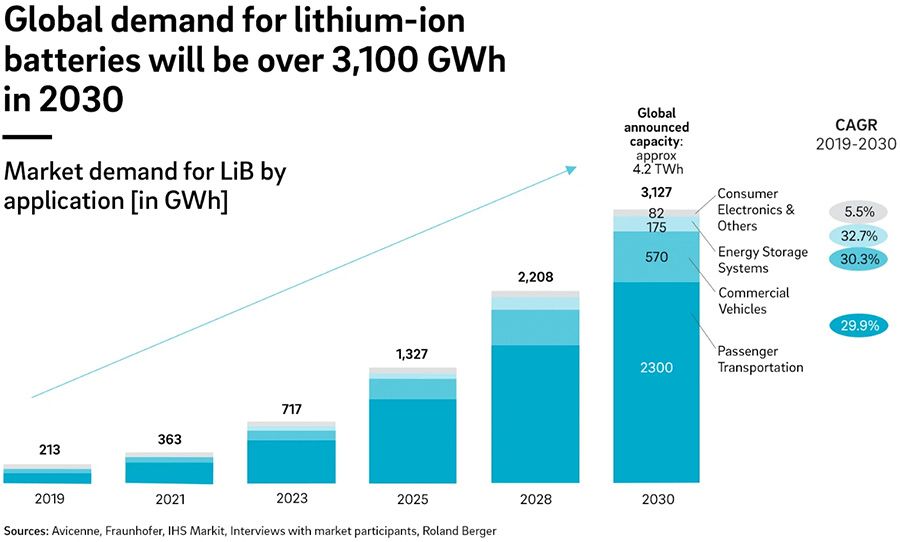
“ENVIRONMENTALLY FRIENDLY CARS WILL SOON CEASE TO BE AN OPTION…THEY WILL BECOME A NECESSITY.” –Fujio Cho
Table of Contents
Electric Vehicle Batteries
The auto industry has always been a business playing a significant role in the economy, by creating jobs, providing government revenues, and supporting both small and large businesses. In this respect, the future of the transportation industry is electric vehicles.
Lithium-ion batteries have changed our regular daily existences, establishing the groundwork for a remote, interconnected, and petroleum product-free society. Their true capacity is, nonetheless, yet to be reached.
The future of the automotive industry is electric and includes driverless cars. This is not a guess or a prediction, it’s an established fact. Western governments in particular are putting out ambitious plans to ban the sale of new gasoline and diesel cars. The US, UK, Norway, and France among others want to see all new cars sold being electric-only by ~2030-2040.
It is estimated that somewhere between 2020 and 2030, the worldwide interest in lithium-ion batteries will increment elevenfold, arriving at more than two terawatt-hours in 2030. Quite a bit of this development can be credited to the rising prevalence of electric vehicles which dominatingly depend on lithium-ion batteries for power.

Thus, the worldwide lithium-particle battery market is supposed to altogether develop too. While estimated at around 40.5 billion U.S. dollars in 2020, the market ought to arrive at the size of around 91.9 billion U.S. dollars in 2030.
Market Statistics for Electric Vehicle Batteries
The global electric vehicle battery market was valued at $23 billion in 2017 and is expected to reach $84 billion by 2025, increasing at a CAGR of 17.2% from 2018 to 2025 (source). Over the past two decades, the emergence of Lithium-ion technology has accelerated the growth rate of batteries.
While nickel-metal hydride (NiMH) batteries were used in the first hybrid vehicles, automakers have increasingly turned to lithium-ion batteries to power plug-in hybrid electric vehicles (PHEVs) and battery electric vehicles (BEVs) (BEVs). Li-ion’s progress as battery technology has been accelerated by its high energy density, charge retention capacity, and low maintenance requirements. Automobile manufacturers are introducing battery electric vehicles (BEVs) and plug-in hybrid electric vehicles (PHEVs) to the EV market.
As automobile manufacturers introduce battery-operated electric vehicles (BEVs) and plug-in hybrid electric vehicles (PHEVs), they are expected to offer lithium ion-powered solutions as the primary power source.
A battery is used as a secondary power source in automobiles.
An electric vehicle battery is a secondary (rechargeable) battery. It uses chemical energy stored in rechargeable battery packs for electricity and therefore requires no combustion engines for propulsion.
An electric vehicle battery or traction battery powers the propulsion of battery electric vehicles.
In recent years, consumers are more inclined toward battery-electric/plug-in vehicles, because these vehicles run without fuel, such as petrol, diesel, and gasoline, and have lower maintenance costs, which eventually reduces consumers’ expenses.
According to the statistics provided by the German Federal Motor Transport Authority, there is a 61% increase in plug-in EV (electric vehicle) sales in 2018 as compared to that in 2017. Thus, the environment-friendly nature of electric vehicles drives the growth of the electric vehicle battery market.
The Difficulties of being in the Electric Vehicle Industry
With so many electric cars on the market, it’s easy to think that it is a business with extraordinary returns in the future, especially now with Tesla. But it is important to note that the electric vehicle industry is one of the biggest and most difficult businesses, not just because of how hard it is to create a proper battery, but also because it is extremely difficult to gather the technical support required to sustain in this industry for a long time.
The company that tries to enter this market surely faces a lot of difficulties. Because it is still in its growth phase, with many new entrants and start-ups popping up, it can be quite a difficult scene to navigate.
EV technology continues to advance quickly – much of which is driven by the development of lithium-ion batteries – but the industry lacks some technical and infrastructural support that makes mass-market adoption difficult.
Moreover, the automobile industry is dominated by major corporations and in many cases, the regulatory bodies that oversee them.
Vehicle manufacturers and oil companies have a lot of money invested into current business models and can be very difficult to change due to their position of power. There are a lot of reasons for that – technology, market share, costs, and incentives are all major parts of it.
The biggest challenge, however, is overcoming public perception. To most people the technology is still new and unfamiliar – it takes time for people to get used to something new. The electric car industry has been fighting this battle for a while now.
Conclusion
To conclude, the market size for these vehicles is set to grow exponentially in the coming years, and it’s already generating a lot of interest.
The future is bright for companies that either manufacture or invest in electric car/bike batteries.
And because this is such a new and innovative field, a lot of resources are still being pumped into research and development. In other words, there are plenty of opportunities out there. If you have the desire and capacity to conduct business in this industry, now may be the best time to do so.






